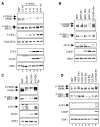Endoplasmic reticulum stress and the unfolded protein response in cellular models of Parkinson's disease
- PMID: 12486162
- PMCID: PMC6758450
- DOI: 10.1523/JNEUROSCI.22-24-10690.2002
Endoplasmic reticulum stress and the unfolded protein response in cellular models of Parkinson's disease
Abstract
6-hydroxydopamine, 1-methyl-4-phenyl-pyridinium (MPP+), and rotenone cause the death of dopaminergic neurons in vitro and in vivo and are widely used to model Parkinson's disease. To identify regulated genes in such models, we performed serial analysis of gene expression on neuronal PC12 cells exposed to 6-hydroxydopamine. This revealed a striking increase in transcripts associated with the unfolded protein response. Immunoblotting confirmed phosphorylation of the key endoplasmic reticulum stress kinases IRE1alpha and PERK (PKR-like ER kinase) and induction of their downstream targets. There was a similar response to MPP+ and rotenone, but not to other apoptotic initiators. As evidence that endoplasmic reticulum stress contributes to neuronal death, sympathetic neurons from PERK null mice in which the capacity to respond to endoplasmic reticulum stress is compromised were more sensitive to 6-hydroxydopamine. Our findings, coupled with evidence from familial forms of Parkinson's disease, raise the possibility of widespread involvement of endoplasmic reticulum stress and the unfolded protein response in the pathophysiology of this disease.
Figures





Similar articles
-
Protective function of SLC30A10 induced via PERK-ATF4 pathway against 1-methyl-4-phenylpyridinium.Biochem Biophys Res Commun. 2017 Sep 2;490(4):1307-1313. doi: 10.1016/j.bbrc.2017.07.018. Epub 2017 Jul 5. Biochem Biophys Res Commun. 2017. PMID: 28688763
-
Parkinsonian mimetics induce aspects of unfolded protein response in death of dopaminergic neurons.J Biol Chem. 2003 May 23;278(21):19367-77. doi: 10.1074/jbc.M211821200. Epub 2003 Feb 21. J Biol Chem. 2003. PMID: 12598533
-
Regulation of the unfolded protein response via S-nitrosylation of sensors of endoplasmic reticulum stress.Sci Rep. 2015 Oct 8;5:14812. doi: 10.1038/srep14812. Sci Rep. 2015. PMID: 26446798 Free PMC article.
-
Mechanisms of disordered neurodegenerative function: concepts and facts about the different roles of the protein kinase RNA-like endoplasmic reticulum kinase (PERK).Rev Neurosci. 2018 Jun 27;29(4):387-415. doi: 10.1515/revneuro-2017-0071. Rev Neurosci. 2018. PMID: 29303785 Review.
-
Modulation of endoplasmic reticulum stress in Parkinson's disease.Eur J Pharmacol. 2015 Oct 15;765:154-6. doi: 10.1016/j.ejphar.2015.08.033. Epub 2015 Aug 20. Eur J Pharmacol. 2015. PMID: 26297973 Review.
Cited by
-
ER stress inhibits neuronal death by promoting autophagy.Autophagy. 2012 Jun;8(6):915-26. doi: 10.4161/auto.19716. Epub 2012 Jun 1. Autophagy. 2012. PMID: 22660271 Free PMC article.
-
Phosphorylation of the alpha subunit of translation initiation factor-2 by PKR mediates protein synthesis inhibition in the mouse brain during status epilepticus.Biochem J. 2006 Jul 1;397(1):187-94. doi: 10.1042/BJ20051643. Biochem J. 2006. PMID: 16492139 Free PMC article.
-
Thiamine deficiency induces endoplasmic reticulum stress in neurons.Neuroscience. 2007 Feb 9;144(3):1045-56. doi: 10.1016/j.neuroscience.2006.10.008. Epub 2006 Nov 28. Neuroscience. 2007. PMID: 17137721 Free PMC article.
-
Interaction with the unfolded protein response reveals a role for stargazin in biosynthetic AMPA receptor transport.J Neurosci. 2005 Feb 2;25(5):1095-102. doi: 10.1523/JNEUROSCI.3568-04.2005. J Neurosci. 2005. PMID: 15689545 Free PMC article.
-
Senolytic and senomorphic secondary metabolites as therapeutic agents in Drosophila melanogaster models of Parkinson's disease.Front Neurol. 2023 Sep 28;14:1271941. doi: 10.3389/fneur.2023.1271941. eCollection 2023. Front Neurol. 2023. PMID: 37840914 Free PMC article. Review.
References
-
- Bence NF, Sampat RM, Kopito RR. Impairment of the ubiquitin-proteasome system by protein aggregation. Science. 2001;292:1552–1555. - PubMed
-
- Bertolotti A, Zhang Y, Hendershot LM, Harding HP, Ron D. Dynamic interaction of BiP and ER stress transducers in the unfolded-protein response. Nat Cell Biol. 2000;2:326–332. - PubMed
-
- Betarbet R, Sherer TB, MacKenzie G, Garcia-Osuna M, Panov AV, Greenamyre JT. Chronic systemic pesticide exposure reproduces features of Parkinson's disease. Nat Neurosci. 2000;3:1301–1306. - PubMed
-
- DeGracia DJ, Sullivan JM, Neumar RW, Alousi SS, Hikade KR, Pittman JE, White BC, Rafols JA, Krause GS. Effect of brain ischemia and reperfusion on the localization of phosphorylated eukaryotic initiation factor 2α. J Cereb Blood Flow Metab. 1997;17:1291–1302. - PubMed
Publication types
MeSH terms
Substances
Grants and funding
LinkOut - more resources
Full Text Sources
Other Literature Sources
Research Materials
